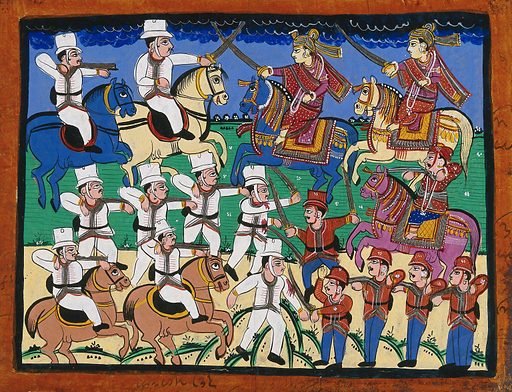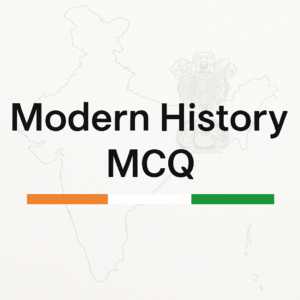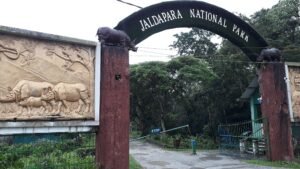Indian history mcq: ancient | medieval | modern
Sharpen your Indian history prep with 30 exam-focused MCQs spanning ancient to modern periods. Designed for UPSC, SSC, and other competitive tests, these questions cover major events, notable rulers, and crucial reforms
- Which Harappan site is known for having a dockyard?
A) Lothal
B) Harappa
C) Mohenjo-daro
D) KalibanganShow Answer
A
- Sabha and Samiti were two assemblies of the:
A) Mauryan Empire
B) Gupta Empire
C) Rig Vedic Aryans
D) Sangam TamilsShow Answer
C
- The language and script of Ashoka’s Major Rock Edicts in most regions were:
A) Sanskrit in Brahmi
B) Prakrit in Brahmi
C) Prakrit in Kharosthi
D) Pali in BrahmiShow Answer
B
- The Arthashastra was authored by:
A) Bhasa
B) Kautilya (Chanakya)
C) Megasthenes
D) PatanjaliShow Answer
B
- The Mehrauli Iron Pillar inscription referring to “King Chandra” is generally associated with:
A) Samudragupta
B) Chandragupta II
C) Skandagupta
D) Kumaragupta IShow Answer
B
- Nalanda Mahavihara was traditionally founded during the reign of:
A) Kumaragupta I
B) Ashoka
C) Harshavardhana
D) DharmapalaShow Answer
A
- Hampi served as the capital of the:
A) Chola Empire
B) Bahmani Sultanate
C) Vijayanagara Empire
D) Kakatiya KingdomShow Answer
C
- The silver “Tanka” and copper “Jital” coins were introduced by:
A) Iltutmish
B) Alauddin Khalji
C) Balban
D) Muhammad bin TughlaqShow Answer
A
- Alauddin Khalji’s market regulations primarily aimed at:
A) Promoting foreign trade
B) Controlling prices and ensuring supplies to the army
C) Introducing token currency
D) Increasing customs revenuesShow Answer
B
- The Sultan who attempted the introduction of token currency in copper and brass was:
A) Alauddin Khalji
B) Muhammad bin Tughlaq
C) Firuz Shah Tughlaq
D) Sher Shah SuriShow Answer
B
- The Battle of Talikota (1565) led to:
A) The end of the Bahmani Sultanate
B) The rise of the Marathas
C) The decline of the Vijayanagara Empire
D) The establishment of Mughal rule in the DeccanShow Answer
C
- The Mansabdari system was introduced by:
A) Babur
B) Akbar
C) Sher Shah Suri
D) AurangzebShow Answer
B
- Akbar’s Din-i Ilahi was:
A) A new spiritual order with a small number of followers
B) A land revenue settlement
C) A market control policy
D) A military recruitment codeShow Answer
A
- The Jizya tax was reimposed by Aurangzeb in:
A) 1658
B) 1665
C) 1679
D) 1707Show Answer
C
- The Ashta Pradhan (Council of Eight Ministers) was instituted by:
A) Akbar
B) Krishnadevaraya
C) Ranjit Singh
D) ShivajiShow Answer
D
- The Battle of Plassey was fought in:
A) 1757
B) 1761
C) 1764
D) 1773Show Answer
A
- The Subsidiary Alliance system in India was introduced by:
A) Lord Cornwallis
B) Lord Wellesley
C) Lord Hastings
D) Sir John ShoreShow Answer
B
- The Doctrine of Lapse is associated with:
A) Lord Canning
B) Lord Ripon
C) Lord Dalhousie
D) Lord CurzonShow Answer
C
- The immediate cause of the Revolt of 1857 was:
A) The annexation of Awadh
B) The introduction of greased cartridges
C) The land revenue settlements
D) The abolition of satiShow Answer
B
- The Indian Councils Act of 1909 (Morley–Minto Reforms) introduced:
A) Provincial dyarchy
B) Separate electorates for Muslims
C) Provincial autonomy
D) A federal courtShow Answer
B
- The Government of India Act, 1919 (Montagu–Chelmsford Reforms) provided for:
A) Dyarchy in the provinces
B) Separate electorates for Sikhs
C) Complete responsible government at the Centre
D) Abolition of communal electoratesShow Answer
A
- The Non-Cooperation Movement was withdrawn by Gandhi in 1922 after:
A) The Jallianwala Bagh massacre
B) The Chauri Chaura incident
C) His arrest and imprisonment
D) The arrival of the Simon CommissionShow Answer
B
- Gandhi’s Salt March from Sabarmati to Dandi began on:
A) 12 March 1930
B) 26 January 1930
C) 15 August 1930
D) 2 October 1930Show Answer
A
- The Poona Pact (1932) was an agreement between:
A) Gandhi and Ambedkar
B) Gandhi and Irwin
C) Nehru and Jinnah
D) Bose and Subhas’s INA leadershipShow Answer
A
- The Quit India Resolution (1942) was adopted at:
A) Lahore
B) Karachi
C) Bombay
D) DelhiShow Answer
C
- The Cabinet Mission Plan (1946) proposed:
A) Immediate partition of India
B) A unitary system with a strong Centre
C) A federal union with a weak Centre
D) Dominion status for princely states onlyShow Answer
C
- The Constituent Assembly adopted the Constitution of India on:
A) 15 August 1947
B) 26 November 1949
C) 26 January 1950
D) 9 December 1946Show Answer
B
- India’s First Five-Year Plan covered the period:
A) 1947–1952
B) 1951–1956
C) 1956–1961
D) 1961–1966Show Answer
B
- The Arya Samaj was founded by:
A) Swami Vivekananda
B) Raja Ram Mohan Roy
C) Swami Dayanand Saraswati
D) Ishwar Chandra VidyasagarShow Answer
C
- The Vernacular Press Act (1878) was enacted under the viceroyalty of:
A) Lord Lytton
B) Lord Ripon
C) Lord Curzon
D) Lord CanningShow Answer
A
Great job completing the quiz. For structured exam prep, bookmark this page and revisit until you’re consistently scoring 27+/30. Next, move through our topic-wise sets (Ancient, Medieval, Modern), previous-year pattern drills, and timed mocks to build accuracy and speed. If you spot an error or want a clarification, leave a comment and we’ll verify with standard sources. Preparing for UPSC/SSC/State PCS? Subscribe for weekly Indian history MCQs, crisp revision notes, and syllabus trackers to keep your preparation on course. Keep practicing—mastery comes with regular, targeted revision.
50 Important Poona Pact MCQs | Poona Pact History
The Poona Pact 1932 | Historical Significance, Key Provisions, and Impact on Dalit Rights
The Battle of Plassey – A Turning Point in Indian History
Champaran Satyagraha – The First Mass Struggle for Freedom in India







